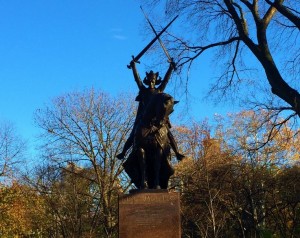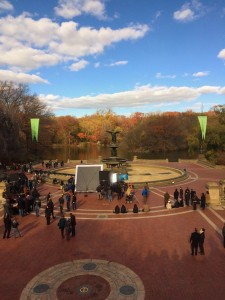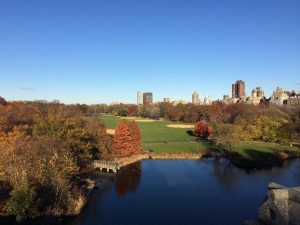By Liam Haber, FCLC ’19

There is a statue in the middle of Central Park of a Polish king, called the King Jagiello Monument. It was first presented at the 1939 World’s Fair, which was held in Flushing, Queens. Intended to be returned following the end of the Fair, the Nazi invasion of Poland prevented any transfer of the monument back to its homeland. Instead, the statue moved from Queens to Central Park, now sitting just east of Turtle Pond, in the shadow of the Metropolitan Museum of Art. It has been in this location since 1945, guarding the center of the park for the past 70 years. I learned all of this from Allison, a maintenance worker with the Central Park Conservancy who was my third stop on my trek around the park that ties all of Manhattan together.
While running through the park a few weeks ago, I noticed that I always went on nearly the same path. I’d start in Columbus Circle, continue on the road past the Mall and the Boathouse to the Ramble, where I’d struggle to keep going until I exited on Central Park West and returned to Fordham. There were often variations on the theme, but I’d always go the same way through the park without ever paying attention to what was around me, only what was on the road ahead. I never stopped to look at the park around me, to see where I was.
It was then that I decided to write this article. Starting at the Information Booth by the Columbus Circle entrance, I would ask Central Park Conservancy workers what their favorite locations in the park are. I’d go to that place and repeat the process with other workers for five different locations.
And so I began at 12:30 in Columbus Circle with the lovely Sabrina. Sabrina was working at the Information Booth and seemed slightly bored with her day so far, but once I asked my question, she was she seemed to enjoy having anyone at all to talk with. Pulling out one of a stack of maps and a souvenir pen with a squirrel on top, Sabrina pointed me in the direction of the Angel Fountain, also known as Bethesda Fountain, a location in many movies. “Everyone thinks it’s the fountain from Friends,” she whispered to me, “but it isn’t.” I was told to walk along the Writer’s Walk, a lineup of statues of famous authors and poets. “Just go between Columbus and Shakespeare and you can’t miss it,” Sabrina added as I walked off.

Much as Sabrina had said, I quickly recognized the fountain from many different shows and films. Unfortunately, they were filming John Wick 2 that very day, preventing anyone from getting close to the fountain. I took some pictures of what is little more than a film set at the moment, but they cannot truly capture how the magnificence of the fountain when it is working. Worse still, I had been told that the real beauty of Bethesda Terrace is the tiling under the arch leading to the fountain, another area blocked off for filming. So while I didn’t see it that day, it is an excuse to return.

After the fountain, I searched for another person working nearby to tell me their favorite locations in the park. Behind the Loeb Boathouse on the Lake, I met Matt, the self-proclaimed “Monuments Expert” of Central Park. Without a moment’s thought, he told me to go to Cleopatra’s Needle behind the Metropolitan Museum of Art. We discussed the 3000 year old Egyptian obelisk that stands at the edge of the Great Lawn for a while, talking about its history and its beauty. Matt provided some cursory directions towards the Needle, eventually pointing in the general direction of the monument and said “its 70 feet tall, you can’t miss it.”
When I arrived at Cleopatra’s Needle I realized that Matt was right, you can’t miss it. The area surrounding the statue was empty, leaving just myself and an ancient Egyptian artifact jutting out of the ground behind the Met. In order to get the photo below and to capture the entire obelisk, I had to lie on my back angle my camera very carefully. The obelisk looms above everything, casting a perfect shadow with the sun. The monument is older than a majority of the items in the museum it stands behind, but seemed to be invisible to all who walked past. Everyone looks at it, but they don’t attempt to see it. That is their loss.

Partly to find a person to talk to and partly to take in the sights, I walked around most of the Great Lawn, the near geographic center of the park. Along the west end of the Lawn I met Alison, the woman who told me about the Polish King Statue mentioned and seen above. Alison had been raking leaves on the side of the lawn for the entire afternoon, and was happy to have someone to talk to, which we did for almost fifteen minutes before both of us got too cold from standing still. Of all of the people I talked to, Alison is easily the nicest among them. She was the only one who seemed excited to talk to me about her favorite place in the park, the only one who didn’t seem bothered by a question.
Allison sent me on my way, which took me back around the Great Lawn. I ended up walking in circles, but I got a chance to see the Lawn in its entiritiy, taking the photo below of Central Park in all its glory. After making my way around Turtle Pond, I found King Władysław II Jagiello. The statue is far larger than the photo makes it out to be, and once again I implore you as readers to find your way into the park and to the statue above. Pictures cannot provide justice to the grandiosity of the statue itself.

After gathering my bearings and looking for another Central Park worker to talk with, I realized that I was directly in front of the famous Belvedere Castle. Belvedere Castle, as I learned once inside, was originally built in the late 1800s and acted as the site of the New York Meteorological Society until they abandoned the facility in the 1960s. Following this, the Castle was subject to a large amount of vandalism and graffiti until the Conservancy took the Castle back in the 80s, making it into a far more approachable location with some of the best views of the city.
On the balcony of the castle, I was able to get the best view I received all day, an uninhibited look at the north end of Central Park. That picture is below, along with one of the top of the Castle. A worker at the castle (who chose to remain nameless for my article) told me that the weather vanes at the top of the castle still provide the information on wind direction and speed as well as temperature for the entire park. The worker also sent me to my next location, which was The Pond at the southern end of Central Park.


Getting from the castle to The Pond was a bit more troublesome than I’d expected. My path took me through the Ramble, home to crisscrossing paths and heavy forestry seemingly designed to cause confusion. I personally love the Ramble and have found myself wondering through it a number of times, but even I got slightly lost before winding up on the proper side of the forest. I went down towards the Conservatory Water, walking alongside the east end of Central Park until I found myself standing at the gates of the famous Central Park Zoo, the setting for Madagascar.
There’s an admission for the Zoo itself, but it is free to walk alongside the zoo and look in. I was able to watch the seals playing in their tank and I would have spent some more time around the Zoo had a number of tours not shown up at precisely that time. After talking very briefly with one of the people walking through, I learned that all of the marching bands in the Macy’s Thanksgiving Day Parade happened to be in the park on the same day as myself. As it turns out, everyone wants to see Central Park when they get to New York for the first time.

I finally found my way over to The Pond. The man at the Castle who had pointed me here mentioned how much he loved the water fowl that lived here, and how they could come right up and interact with the humans on the shore. While I did not want to be attacked by ducks and geese personally, I did see all of the birds flock to the humans, likely trained to expect food. The Pond was going to be my last stop, but I decided that I had enough time for one more location if it were in an appropriate distance.
Walking away from the pond, I found myself at Wollman Rink, where figure skaters and hockey players were sharing the ice. I stood and watched the skating for a while when Beth, another Central Park worker, walked right up beside me and started talking to me about the rink. After explaining my mission to her, Beth directed me south, towards a location not marked on any map of the park. Between the Pond and my eventual exit of Columbus Circle, the Hallett Nature Sanctuary exists as the third wooded area in the park. Often forgotten in favor of the North Woods and the Ramble, Hallett runs adjacent to Central Park South and overlooks the southern end of the park. She called it one of the nicest looking places in the park.
Evidently, she was correct, and with Beth’s final suggestion I ended my tour, seeing the beautiful view below as my last real look at the park before headed back to school. With my hands frozen and my phone once again dying, it was time to return back to my home with a newfound appreciation of Central Park. But more important than the history of Polish statues or the existence of a secret woods, I learned that Central Park doesn’t just exist. People like Sabrina and Matt and Beth and Alison each exist to make Manhattan’s centerpiece the place that it is. My journey through the park would not be possible were it not for every person who works with the Central Park Conservancy. They are the unsung heroes of New York, maintaining a beauty untouched by the city around it for so many years.

